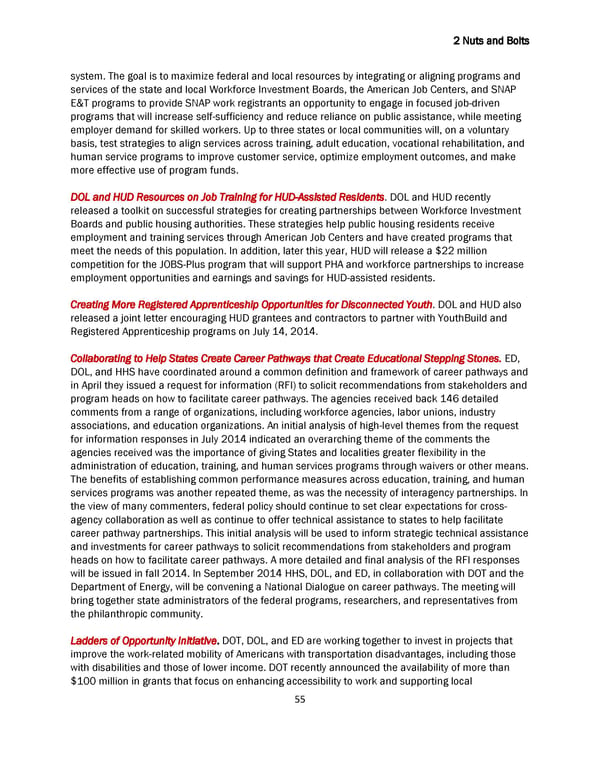2 Nuts and Bolts system. The goal is to maximize federal and local resources by integrating or aligning programs and services of the state and local Workforce Investment Boards, the American Job Centers, and SNAP E&T programs to provide SNAP work registrants an opportunity to engage in focused job-driven programs that will increase self-sufficiency and reduce reliance on public assistance, while meeting employer demand for skilled workers. Up to three states or local communities will, on a voluntary basis, test strategies to align services across training, adult education, vocational rehabilitation, and human service programs to improve customer service, optimize employment outcomes, and make more effective use of program funds. DOL and HUD Resources on Job Training for HUD-Assisted Residents. DOL and HUD recently released a toolkit on successful strategies for creating partnerships between Workforce Investment Boards and public housing authorities. These strategies help public housing residents receive employment and training services through American Job Centers and have created programs that meet the needs of this population. In addition, later this year, HUD will release a $22 million competition for the JOBS-Plus program that will support PHA and workforce partnerships to increase employment opportunities and earnings and savings for HUD-assisted residents. Creating More Registered Apprenticeship Opportunities for Disconnected Youth. DOL and HUD also released a joint letter encouraging HUD grantees and contractors to partner with YouthBuild and Registered Apprenticeship programs on July 14, 2014. Collaborating to Help States Create Career Pathways that Create Educational Stepping Stones. ED, DOL, and HHS have coordinated around a common definition and framework of career pathways and in April they issued a request for information (RFI) to solicit recommendations from stakeholders and program heads on how to facilitate career pathways. The agencies received back 146 detailed comments from a range of organizations, including workforce agencies, labor unions, industry associations, and education organizations. An initial analysis of high-level themes from the request for information responses in July 2014 indicated an overarching theme of the comments the agencies received was the importance of giving States and localities greater flexibility in the administration of education, training, and human services programs through waivers or other means. The benefits of establishing common performance measures across education, training, and human services programs was another repeated theme, as was the necessity of interagency partnerships. In the view of many commenters, federal policy should continue to set clear expectations for cross- agency collaboration as well as continue to offer technical assistance to states to help facilitate career pathway partnerships. This initial analysis will be used to inform strategic technical assistance and investments for career pathways to solicit recommendations from stakeholders and program heads on how to facilitate career pathways. A more detailed and final analysis of the RFI responses will be issued in fall 2014. In September 2014 HHS, DOL, and ED, in collaboration with DOT and the Department of Energy, will be convening a National Dialogue on career pathways. The meeting will bring together state administrators of the federal programs, researchers, and representatives from the philanthropic community. Ladders of Opportunity Initiative. DOT, DOL, and ED are working together to invest in projects that improve the work-related mobility of Americans with transportation disadvantages, including those with disabilities and those of lower income. DOT recently announced the availability of more than $100 million in grants that focus on enhancing accessibility to work and supporting local 55
 Biden Ready to Work White Paper 7/22/14 Page 54 Page 56
Biden Ready to Work White Paper 7/22/14 Page 54 Page 56